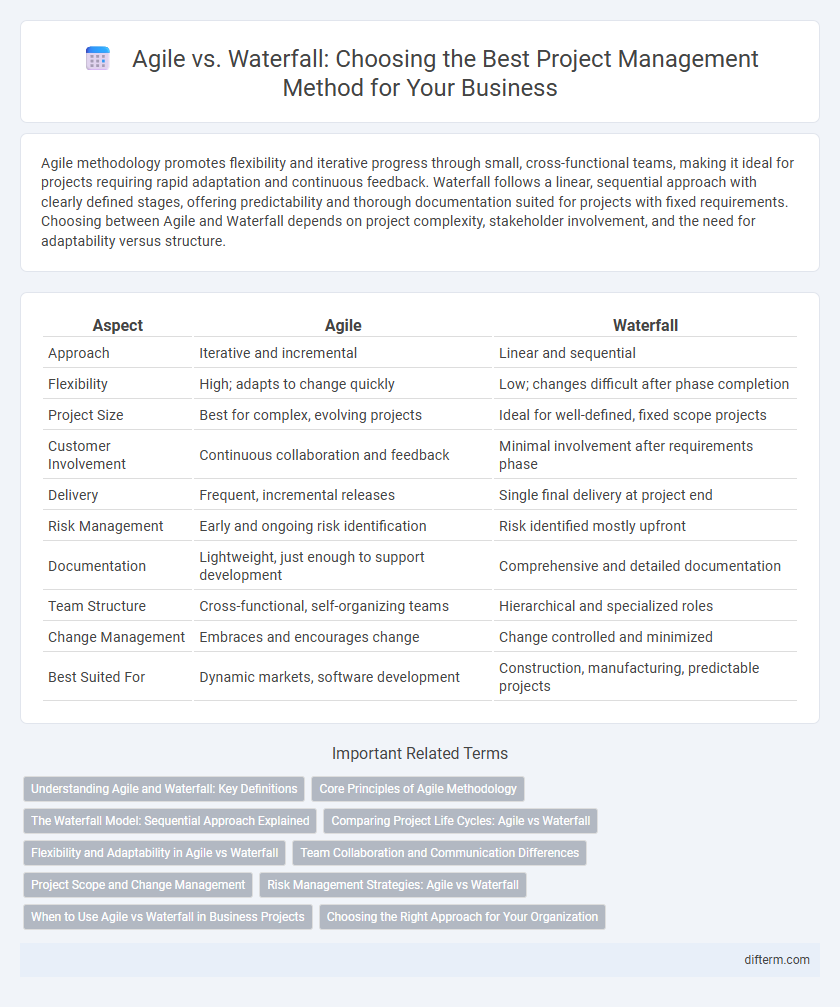Agile methodology promotes flexibility and iterative progress through small, cross-functional teams, making it ideal for projects requiring rapid adaptation and continuous feedback. Waterfall follows a linear, sequential approach with clearly defined stages, offering predictability and thorough documentation suited for projects with fixed requirements. Choosing between Agile and Waterfall depends on project complexity, stakeholder involvement, and the need for adaptability versus structure.
Table of Comparison
| Aspect | Agile | Waterfall |
|---|---|---|
| Approach | Iterative and incremental | Linear and sequential |
| Flexibility | High; adapts to change quickly | Low; changes difficult after phase completion |
| Project Size | Best for complex, evolving projects | Ideal for well-defined, fixed scope projects |
| Customer Involvement | Continuous collaboration and feedback | Minimal involvement after requirements phase |
| Delivery | Frequent, incremental releases | Single final delivery at project end |
| Risk Management | Early and ongoing risk identification | Risk identified mostly upfront |
| Documentation | Lightweight, just enough to support development | Comprehensive and detailed documentation |
| Team Structure | Cross-functional, self-organizing teams | Hierarchical and specialized roles |
| Change Management | Embraces and encourages change | Change controlled and minimized |
| Best Suited For | Dynamic markets, software development | Construction, manufacturing, predictable projects |
Understanding Agile and Waterfall: Key Definitions
Agile is a flexible project management methodology emphasizing iterative development, continuous feedback, and adaptive planning, commonly used in software development to enhance collaboration and responsiveness. Waterfall is a linear, sequential approach where each phase must be completed before the next begins, offering clear structure and documentation ideal for projects with well-defined requirements. Understanding these key definitions enables businesses to select the most suitable framework based on project complexity, team dynamics, and delivery timelines.
Core Principles of Agile Methodology
Agile methodology emphasizes iterative development, customer collaboration, and adaptive planning to enhance flexibility and responsiveness throughout the project lifecycle. Its core principles include delivering working software frequently, welcoming changing requirements even late in development, and fostering close daily collaboration between cross-functional teams. These practices contrast with Waterfall's linear, sequential approach, enabling Agile teams to respond rapidly to feedback and evolving business needs.
The Waterfall Model: Sequential Approach Explained
The Waterfall Model is a linear, sequential approach to project management where each phase, including requirements, design, implementation, verification, and maintenance, must be completed before the next begins. This method emphasizes thorough documentation and upfront planning, making it ideal for projects with well-defined requirements and minimal expected changes. Its structured nature facilitates clear milestones and deliverables but can lack flexibility when adapting to evolving business needs compared to Agile methodologies.
Comparing Project Life Cycles: Agile vs Waterfall
Agile project life cycles emphasize iterative development, enabling continuous feedback and adaptive planning, which enhances flexibility and responsiveness to change. Waterfall follows a linear, sequential approach with distinct and fixed phases, promoting thorough documentation but limiting adaptability once the project is underway. Choosing between Agile and Waterfall depends on project complexity, stakeholder involvement, and the need for flexibility versus predictability.
Flexibility and Adaptability in Agile vs Waterfall
Agile methodology offers superior flexibility and adaptability by embracing iterative development, continuous feedback, and rapid response to change, enabling businesses to adjust priorities and deliverables in real time. In contrast, the Waterfall model follows a rigid, sequential approach with predefined phases, making it difficult to accommodate changes once the project is underway, which can lead to delays and increased costs. Organizations seeking dynamic project management and quick pivots favor Agile for its ability to align with evolving customer demands and market conditions.
Team Collaboration and Communication Differences
Agile emphasizes continuous team collaboration through daily stand-ups, sprint planning, and retrospective meetings, fostering real-time feedback and adaptive communication. Waterfall follows a linear, sequential process with less frequent, structured communication, often leading to delayed feedback and siloed roles. Agile's iterative approach enhances transparency and responsiveness, while Waterfall relies on predefined documentation and phased handoffs that can hinder dynamic interaction.
Project Scope and Change Management
Agile methodology promotes flexible project scope with iterative development, allowing continuous adjustments based on stakeholder feedback and evolving requirements. Waterfall follows a fixed project scope defined upfront, with limited scope changes after initial planning, emphasizing thorough documentation. Change management in Agile is adaptive and embraces scope modifications, whereas Waterfall requires formal change requests and approval processes to control scope alterations.
Risk Management Strategies: Agile vs Waterfall
Agile employs iterative development and continuous feedback loops to identify and mitigate risks early, adapting quickly to changes and minimizing project uncertainties. Waterfall emphasizes thorough upfront planning and sequential phases, aiming to predict and control risks through detailed documentation and predefined processes. Agile's flexibility contrasts with Waterfall's structured risk avoidance, making Agile more effective in dynamic environments while Waterfall suits projects with well-defined requirements.
When to Use Agile vs Waterfall in Business Projects
Agile suits business projects requiring flexibility, rapid iteration, and frequent client feedback, especially in dynamic markets or software development. Waterfall is ideal for projects with clearly defined requirements, fixed scopes, and tight regulatory constraints, such as construction or manufacturing. Choosing Agile accelerates adaptability, while Waterfall ensures structured progress for predictable, linear project outcomes.
Choosing the Right Approach for Your Organization
Selecting the appropriate project management methodology depends on your organization's flexibility, project complexity, and delivery timelines. Agile thrives in dynamic environments requiring continuous feedback and iterative development, while Waterfall suits projects with well-defined scope and fixed requirements. Aligning methodology choice with organizational culture and stakeholder expectations ensures optimal efficiency and project success.
Agile vs Waterfall Infographic

 difterm.com
difterm.com